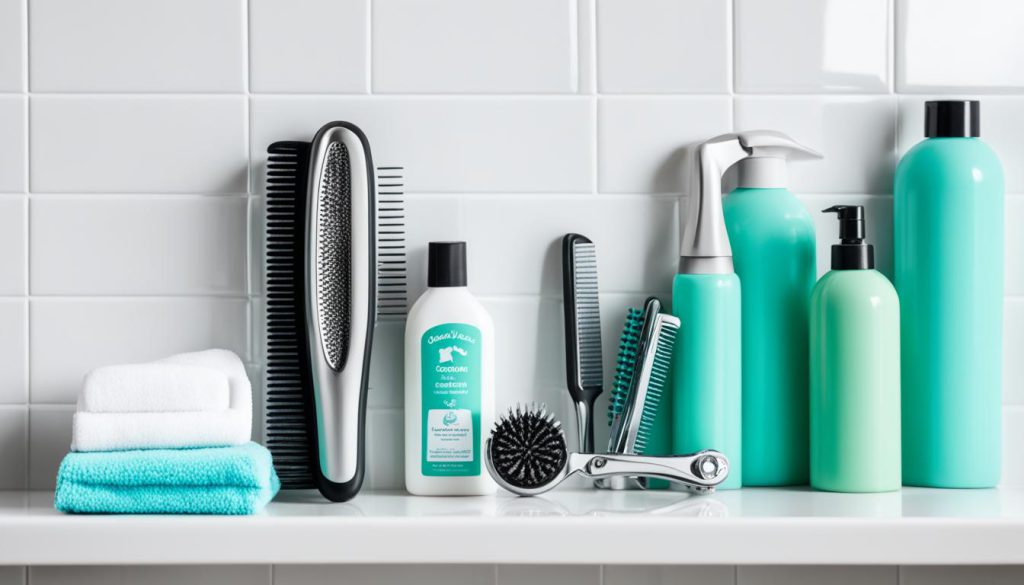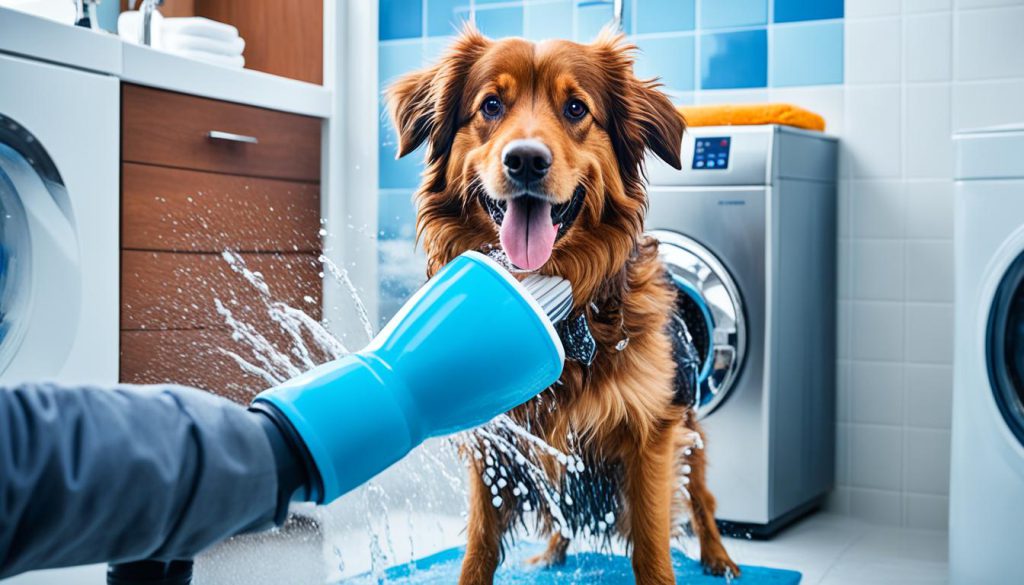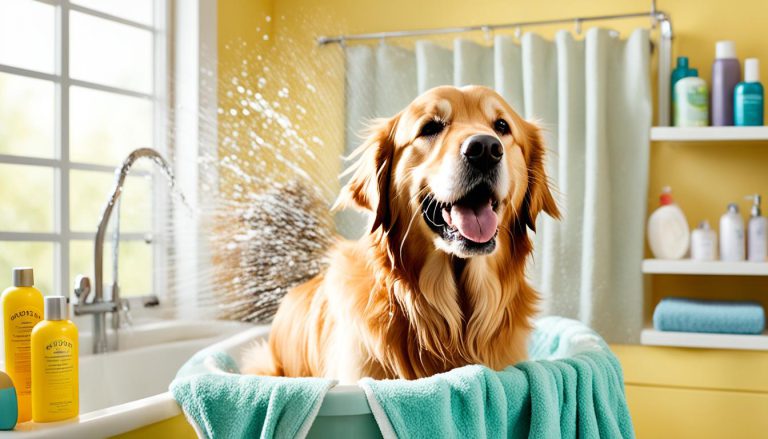Bathing your dog too often can hurt their skin and coat. Many pet owners don’t know that washing them more than once a week is bad. Bathing your dog can be easy and fun, with the right approach.
To bathe your dog at home, you’ll need the correct supplies. You should have dog shampoo, conditioner, brushes, towels, and treats. A step-by-step guide makes bath time a chance to bond, not just a task.
Pro grooming tips can help your dog enjoy baths. Whether you have a Husky needing frequent brushes or a Pit Bull that’s easy to wash. These tips will simplify your bath routine.
Key Takeaways
- Bathing your dog more than once a week can harm their skin and fur.
- Have all necessary supplies ready before you start.
- Different breeds have unique bathing needs; research accordingly.
- Transform bath time into a positive, bonding experience for your dog.
- Use dog-specific shampoos and conditioners to avoid skin irritation.
Why Regular Bathing is Important for Your Dog’s Health
Keeping your dog clean is more than making them smell nice. It’s vital for their health. Regular washing has many benefits for your furry friend’s wellbeing.
Benefits of Regular Bathing
How often you bathe your dog depends on their breed, how active they are, and their skin type. Still, regular baths have clear advantages:
- Reduction in shedding: Regular baths help manage your dog’s hair, making it easier to keep your home clean.
- Allergen control: Dogs that receive frequent baths are less likely to carry allergens in their fur, benefiting both the dog and allergic owners.
- Health monitoring: Bathing provides an opportunity to check for any abnormalities in ears, teeth, nails, skin, or the presence of fleas, mites, or lice.
Common Health Issues from Poor Hygiene
Not bathing your dog can lead to health problems. For example, they could get:
- Skin infections: Dirt and bacteria can cause infections, leading to discomfort and potential vet visits.
- Parasite infestations: Bugs like fleas and mites thrive on unclean skin and fur, causing irritation and health problems.
- Unpleasant odors: Foul smells are often an indicator of underlying health issues that need addressing.
By keeping your dog clean with regular baths, you help them stay healthy. It’s vital for every dog owner who wants a happy and healthy pet.
Choosing the Right Dog Shampoo
Choosing the best dog shampoo is key for your dog’s grooming. Owners usually wash their dogs every 4-5 weeks. It’s crucial because dog shampoos are made for their skin’s pH level. This helps avoid irritation and keeps their coat’s natural oils.
When picking a shampoo, the ingredients matter a lot. Parabens in some shampoos can increase cancer risks in dogs. Ingredients like 2-bromo-2-nitropropane-1,3-diol can also harm their health long-term. I look for shampoos without artificial dyes and colors, avoiding petroleum-based harmful ones.
Surfactants like Sodium lauryl sulfate (SLS) might irritate and stay in a dog’s organs for days. Cocamide-MEA can mix with nitrosamines, which are known to cause cancer. It’s important to choose carefully.
Dogs have different coat types, needing specific shampoos. Single-coated breeds might bathe less often than double-coated ones. The right shampoo promotes healthier skin and less shedding. This can also help with allergies.
| Shampoo Type | Price | Ideal For |
|---|---|---|
| Organic Puppy Love Shampoo | £7.00 | Puppies with delicate skin |
| Organic Senior Shampoo | £5.00 | Older dogs needing gentle care |
The American Kennel Club advises using natural ingredients and avoiding parabens and dyes. Knowing your dog’s coat and careful ingredient selection can make their bath safe and effective. This contributes to their happiness and health.
For a happy bath time, get your dog comfortable in the tub first. Brush them before shampooing and make sure the water is warm. Rinse thoroughly to avoid skin irritation. With the right shampoo and care, grooming can be easy and fun.
Prepping Your Pooch: Brushing Before the Bath
Before jumping into the bath, it’s key to brush your dog first. This important grooming step gets rid of loose fur and tangles. It stops mats that get worse when wet.
Why You Should Brush Your Dog Before Bathing
Brushing removes dirt and stuff stuck in their fur. It makes diy dog grooming easier and better. It prevents drain clogs and smooths out the bath process. This prep not only readies the coat but also aids in easier drying after.
The Best Brushes for Different Coat Types
Choosing the right brush is based on your dog’s fur type. A slicker brush is good for long and curly breeds. Short-haired dogs do well with a bristle brush. An undercoat rake suits dogs with double-layer coats.
| Coat Type | Recommended Brush |
|---|---|
| Short Hair | Bristle Brush |
| Long Hair | Slicker Brush |
| Curly Hair | Slicker Brush |
| Double Layer | Undercoat Rake |
Proper brushing is both simple and crucial in pet grooming. It ensures a cleaner and easier-to-manage coat. Remember, brushing well leads to a cleaner dog and a smoother grooming session!
Essential Dog Bathing Supplies
Having the right dog bath essentials ready can make bath time fun for you and your dog. It’s key to have everything you need before starting. This keeps the bath organized and calm.
Basic Supplies You’ll Need
First, let’s talk about the basic dog bath essentials for any bath:
- Dog-friendly shampoo and conditioner: Pick a good dog shampoo. Look for one with natural ingredients to keep your dog’s skin and fur healthy. A recommended product is the Veterinary Formula Clinical Care Antiparasitic & Antiseborrheic Dog Shampoo, at $8.96 on Chewy.
- Towels: Get several absorbent towels ready for effective drying.
- Brushes: Brushing before a bath helps with coat health. The Hertzko Self-Cleaning Dog & Cat Slicker Brush, for $16.99 on Chewy, is a top choice.
- Cleansing facial wipes: Grooming wipes are a quick, dry option to keep your dog fresh. They help avoid frequent baths and protect against dry skin.
Optional Tools for a Smoother Bath
There are also optional tools to make the bath even better:
- Non-slip mat: A non-slip mat gives your dog stability, making the bath more comfortable for them and simpler for you.
- Extra towels for splashes: Extra towels can catch unexpected splashes and keep the place dry.
- Treats for positive reinforcement: Treats help your dog stay calm and happy during the bath. Try Old Mother Hubbard Classic Puppy Biscuits, available for $5.47 on Chewy.
- Blow dryer: A blow dryer, like the ConairPRO Professional Dog Nail Grinder at $33.42 on Chewy, dries thick or long coats well. Always use a cool setting to avoid overheating.

Creating a Comfortable Bathing Environment
Creating a comfortable dog wash environment is crucial for a stress-free bath time. It’s all about ensuring both you and your dog feel relaxed. By taking the right steps, you can make bathing enjoyable.
Choosing the Right Spot
Choosing the right spot is vital for a comfortable dog wash. Small dogs might fit well in a sink. Larger dogs, however, need a dedicated or portable tub. Ensure the area has a non-slip surface to keep your dog safe.
Setting the Ideal Water Temperature
Getting the water temperature right is key. Use lukewarm water, similar to what you’d use for a baby. This keeps your dog calm and makes bath time pleasant.
Here’s a quick summary of how to prepare a safe and comfy dog wash area:
| Aspect | Details |
|---|---|
| Bathing Spot | Sink for small dogs, dedicated tub for large dogs, non-slip surface |
| Water Temperature | Lukewarm, akin to a human baby’s bath temperature |
| Non-Slip Surface | Important for preventing slips and injuries |
| Calming Environment | Use treats, positive reinforcement, and soothing music |
By adhering to these tips, you can craft a comfortable dog wash space. Your pup will feel secure and chilled out. This not only makes bathing fun but also strengthens your bond.
Bathing Your Dog
Bathing your dog does more than keep them clean; it helps you bond and look after their health, too. By following clear dog washing steps, the task becomes easier. This guide teaches you how to bathe a dog at home in the right way.
Step-by-Step Guide
- Brush the Coat: Start by thoroughly brushing your dog’s coat. This removes loose fur and prevents knots. Use bristle brushes for any coat type, wire pin brushes for medium to long hair, and slicker brushes for detangling.
- Gather Supplies: Ready all your bathing supplies before you start. You’ll need dog shampoo, conditioner (for long or fine fur), towels, and a handheld showerhead for ease.
- Prepare the Bathing Area: Pick a safe, comfy spot for the bath. A non-slip mat can help prevent slips. For bigger dogs, a portable tub is a great choice and easy to put away.
- Wetting the Coat: Wet your dog’s coat well with lukewarm water. Aim for between 90 to 98 degrees Fahrenheit to keep their skin from drying.
- Apply Shampoo: Choose a shampoo made for dogs to keep their skin’s oils and pH balanced. Lather from the neck down, but avoid getting it in their eyes and nose.
- Rinवंse: Rinse your dog well to get all the shampoo out. Leftover soap can irritate their skin.
- Condition (if needed): If your dog has long hair, like a Golden Retriever, use conditioner to prevent tangles.
- Dry your Dog: Start by towel drying to remove excess water. For long-haired dogs, use a blow dryer made for pets, which is gentler than those for humans.
- Reward your Dog: Give treats to make bath time positive. This makes the next bath easier for both of you.
Common Mistakes to Avoid
- Skipping the Pre-Brush: Not brushing before the bath can lead to mats and make the bath less effective.
- Improper Rinsing: Make sure all shampoo is fully rinsed off to avoid skin problems from soap residue.
- Inadequate Preparation: Not having your supplies ready can make bath time stressful for your dog.
- Using Hot Water: Always use water that’s warm, not hot, to keep your dog comfortable and their skin healthy.
- Neglecting Sensitive Areas: Be careful around the eyes and ears. Use cotton balls in the ears to keep water out and prevent discomfort or infections.
- Improper Drying: Always dry your dog thoroughly to avoid skin issues. Make sure they’re completely dry before leaving the bath area.
Keeping Water Out of Your Dog’s Ears
It’s key to keep your pet’s ears clean and dry for their health. Dogs with floppy ears, like Golden Retrievers, get ear infections easily because of moisture. Knowing how to keep their ears dry is crucial to stop infections and hearing loss.
Using Cotton Balls for Protection
To protect your dog’s ears from water, you can use cotton balls. Just gently place one in each ear during baths or swimming. This stops water from getting in and prevents infections. But, make sure not to push them in too far to avoid hurting your dog.
Cleaning Ears Post-Bath
After bathing your dog, it’s important to clean their ears. This removes any water that could harm their hygiene. Use a special dog ear cleaner recommended by vets to keep their ears dry and clean. You can also use a homemade mixture of hydrogen peroxide or apple cider vinegar with water.
Don’t use Q-tips though, as they can push dirt further in and cause damage.
Here’s a comparison of ear cleaning solutions:
| Cleaning Method | Effectiveness | Cost |
|---|---|---|
| Veterinarian’s Ear Kit | High | Higher Cost |
| Homemade Solution | Moderate | Budget-Friendly |
| CrittEar Calm Dog Earplugs | High (Prevention) | Moderate |
Keeping your dog’s ears clean and dry lowers infection risks. If you see symptoms like discharge or swelling, see a vet right away.
Proper Lathering Techniques
Starting with the right way to lather up your dog is key. First, make sure your dog is wetting the dog thoroughly. This helps shampoo get all the way to the skin. For dogs with thick fur, like Golden Retrievers, soak them well.
Begin shampooing at the neck and move down to the back and legs. This prevents shampoo from getting into their eyes and ears. Dogs’ shampoo doesn’t foam up like ours does, so you don’t need a lot for it to work.
Work the shampoo into a good lather to clean off dirt and oil. But remember, the main goal is to clean your dog well. The lather helps get rid of any stuck dirt or oil.
Some owners say their dog itches a lot after a bath. This can happen if shampoo is left on the skin. Make sure to rinse your dog well, even if it takes time. This helps keep them comfortable and clean.
If your dog has skin problems, try tea tree shampoo. It’s gentle, natural, and helps with tough knots and dry skin without irritation.
It’s important to keep your dog safe in the bath. Never leave them alone in the bath. Washing your dog carefully and rinsing well not only keeps them clean but also makes drying off easier.
Rinsing Thoroughly: Tips and Tricks
Making sure your dog is fully rinsed after a bath is key to their health. If shampoo stays on, it can irritate the skin and cause discomfort. I learned through trial and error that being thorough in the rinse phase is important.
Importance of Rinsing Well
It’s vital to rinse your dog properly. Leftover shampoo can lead to itching or even dermatitis. This is even more critical for dogs with sensitive skin or allergies. Any remaining product can make their condition worse. A handheld sprayer is great for a complete rinse. It lets you get water close to the skin, covering all spots.
How to Ensure All Shampoo is Removed
To get all the shampoo out, start with lukewarm water and go from top to bottom. Begin at the neck, heading towards the tail. Use a hose with an attachment for more control. This helps get underneath the coat to rinse out all the soap. Focus on the belly, legs, and tail, where shampoo likes to hide.
Regular checks and running your fingers through the fur can help spot any leftover suds. Following these dog washing tips will ensure your dog is completely clean. Their coat will be shiny and healthy.
Drying Your Dog After a Bath
Making sure your dog is dry after a bath is key for their health. You can towel dry or blow dry, but each method needs to be done right. Knowing how to do it can stop skin problems and make grooming better.

Towel Drying vs. Blow Drying
Dog-specific towels, like The Absorber towel, are great. They’re thinner but soak up more water than regular towels. To dry your dog, press the towel against their fur. Do this until they’re mostly dry. Use more towels for larger dogs. When towel drying, don’t rub hard. Carefully squeeze the water from their head down to their paws.
Blow drying works well, especially for dogs with lots of fur. Always use the lowest heat setting and hold the hairdryer a bit away. This stops burns. Move the dryer back and forth slowly. Be careful around the face, ears, and private areas. Places like Pet Fresh Dog Wash have special dryer hoses for this. Medium dogs might need eight passes with the dryer for a good dry.
Preventing Skin Issues through Proper Drying
Drying your dog right is more than just removing water. It helps stop skin problems. If your dog air dries, they could get fungus or matted fur. Using towels or a blow dryer the right way keeps their skin and fur healthy. This prevents hot spots and other issues.
Good drying methods make grooming better. They keep your dog clean, comfy, and healthy. Learning the right way to dry your pet makes the whole process easier. This keeps your dog happy and looking good.
Keeping Your Dog Calm During the Bath
Bath time can be stressful for dogs, but a calm dog bath experience is key. Using the right techniques can make bath time easier for you and your pet.
Using Treats and Praise
I keep treats ready to reward my dog during bath time. Using positive words and treats helps create good bath memories. For example, I give a treat for getting into the tub and another for staying calm while being shampooed.
Starting the bath routine early helps too. Puppies that start baths young are usually less scared. Make it fun, and your dog will eventually enjoy bath time.
Tools to Distract Your Dog
Distraction is great for a calm dog bath experience. Tools like a puzzle toy or peanut butter on the wall can keep your dog busy. A non-slip mat in the tub can also make your dog feel safer.
Slowly getting your dog used to the bath helps too. Slowly introduce them to the bathroom and water. Getting the whole family involved can also make bath time a bonding experience.
The main goal is for bath time to be fun and not scary. Take things slow, so your dog feels comfortable. And if you need extra help, consider professionals like Alpha Paws.
Signs You Should See a Professional Groomer
Sometimes, our furry friends need more than just a bath at home. It’s good to know when to take them to a professional dog groomer. This can prevent a lot of problems for you and your pet.
If your dog’s fur is very tangled, it might be time for professional help. Dogs usually need to be groomed once a month. But, dogs with long hair might need it more often.
Trying to groom a dog that doesn’t like baths can be hard. If it’s always a struggle, a professional groomer can make it easier. They are skilled at keeping your dog calm.
How active your dog is also matters. Dogs that play outside often get dirtier than indoor dogs. They can pick up fleas or ticks that need to be removed.
Keeping your dog’s nails short is also important. If your dog doesn’t walk on hard surfaces much, its nails can get too long. Sometimes, they might even need a groomer for a nail trim.
Groomers do more than just give baths. They can clean your dog’s ears and eyes safely. This is important for dogs like Maltese, who can get tear stains.
Sometimes, health issues like constipation can affect your dog. While a vet should handle these issues, groomers can spot these problems early. Professional groomers also give advice on keeping your dog’s fur healthy.
Conclusion
Bathing your dog at home can strengthen your bond. It keeps them healthy and clean too. When you avoid bathing them too much, you protect their skin. Their skin has oils and good bacteria that are important for their health. This prevents problems like hair mats, which can cause discomfort and infections.
Watch for signs your dog is stressed during bath time. Signs like shaking, panting, or hiding show they’re not enjoying it. Making bath time positive and choosing a cozy spot can help calm their fears. Also, check for things like hair mats, fleas, and wounds when you groom them. Using dog-specific shampoos is crucial, as human products can be harmful.
The right water temperature makes the bath comfortable. Aim for around 98-99 degrees Fahrenheit. If your dog still smells after a bath, a vet check-up might be needed. Sometimes, smells can mean infection or other health issues. But a little wet dog smell is normal, it comes from their natural oils. By following these tips, giving your dog a bath at home can be easy and help in keeping them happy and healthy.
Source Links
- https://www.preventivevet.com/dogs/bathing-a-dog-at-home
- https://www.aspcapetinsurance.com/resources/how-to-give-a-dog-a-bath/
- https://www.dailypaws.com/dogs-puppies/dog-grooming/how-to-bathe-a-dog
- https://pets.waterpik.com/blog/6-benefits-bathing-dog/
- https://doggysquad.store/blogs/news/how-to-choose-dog-shampoo-conditioner
- https://www.akc.org/expert-advice/health/dog-shampoos-find-right-one-dog/
- https://www.houndslounge.com/blog/top-8-tips-to-make-your-dog-baths-easier/
- https://wahlusa.com/how-to/pet-grooming-guides/dog-care/bathing
- https://wahlusa.com/expert-advice/grooming-pets/7-dog-grooming-essentials-every-pet-owner-needs
- https://www.hillspet.com/dog-care/routine-care/supplies-for-washing-your-dog
- https://retrievist.akc.org/essentials/essential-dog-grooming-products/
- https://www.alphapaws.com/12-dog-training-tips-for-a-dog-who-hates-bathing/
- https://www.kohlershowers.com/blog/how-to-bathe-your-dog-in-a-walk-in-shower/
- https://be.chewy.com/how-to-bathe-a-dog-step-by-step-tips-from-a-professional-groomer/
- https://dogloverstowel.com/blogs/news/how-to-remove-water-from-your-dog-s-ears
- https://www.crittear.com/dog-ear-health/keeping-water-out-of-your-dogs-ears-while-bathing/
- https://betterpet.com/water-in-dog-ears/
- https://www.pawpaddogs.co.uk/dog-grooming-bathing-tips-shampoo-dog/
- https://dogloverstowel.com/blogs/news/no-wet-zone-4-methods-for-drying-your-dog-after-a-bath
- https://allpawspetwash.com/tips-on-how-to-dry-a-dog-after-a-bath/
- https://www.petfreshdogwash.com/how-to-properly-dry-your-dog-after-a-bath/
- https://www.akcpetinsurance.com/blog/how-to-curb-bath-time-fear
- https://be.chewy.com/health-grooming-8-ways-to-make-your-dogs-bathtime-less-stressful/
- https://www.crossroadsvh.com/site/blog/2021/11/30/signs-your-dog-needs-grooming
- https://mynbc15.com/features/for-pets-sake/5-signs-its-time-for-a-groomer
- https://anicira.org/resources/guide-to-bathing-your-dog/

